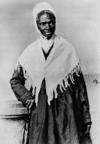- Truth, Sojourner
-
orig. Isabella Van Wagenerborn с 1797, Ulster county, N.Y., U.S.died Nov. 26, 1883, Battle Creek, Mich.U.S. evangelist and social reformer.The daughter of slaves, she spent her childhood as an abused chattel of several masters. After being freed in about 1827, she worked as a domestic in New York City (1829–43) and began preaching on street corners with the evangelical missionary Elijah Pierson. Adopting the name Sojourner Truth, she left New York to obey a "call" to travel and preach. Adding abolitionism and women's rights to her religious messages, she traveled in the Midwest, where her magnetism drew large crowds. At the start of the American Civil War she gathered supplies for black volunteer regiments. In 1864 she went to Washington, D.C., where she helped integrate streetcars and was received at the White House by Pres. Abraham Lincoln. After the war she worked for the freedmen's relief organization and encouraged migration to Kansas and Missouri.
 Sojourner Truth.Courtesy of the Burton Historical Collection, Detroit Public Library
Sojourner Truth.Courtesy of the Burton Historical Collection, Detroit Public Library* * *
▪ American evangelist and social reformerlegal name Isabella Van Wagenerborn c. 1797, Ulster county, N.Y., U.S.died Nov. 26, 1883, Battle Creek, Mich.African American evangelist and reformer who applied her religious fervour to the abolitionist (abolitionism) and women's rights (women's movement) movements.Isabella was the daughter of slaves (slavery) and spent her childhood as an abused chattel of several masters. Her first language was Dutch. Between 1810 and 1827 she bore at least five children to a fellow slave named Thomas. Just before New York state abolished slavery in 1827, she found refuge with Isaac Van Wagener, who set her free. With the help of Quaker friends, she waged a court battle in which she recovered her small son, who had been sold illegally into slavery in the South. About 1829 she went to New York City with her two youngest children, supporting herself through domestic employment.Since childhood Isabella had had visions and heard voices, which she attributed to God. In New York City she became associated with Elijah Pierson, a zealous missionary. Working and preaching in the streets, she joined his Retrenchment Society and eventually his household.In 1843 she left New York City and took the name Sojourner Truth, which she used from then on. Obeying a supernatural call to “travel up and down the land,” she sang, preached, and debated at camp meetings, in churches, and on village streets, exhorting her listeners to accept the biblical message of God's goodness and the brotherhood of man. In the same year, she was introduced to abolitionism at a utopian community in Northampton, Massachusetts, and thereafter spoke in behalf of the movement throughout the state. In 1850 she traveled throughout the Midwest, where her reputation for personal magnetism preceded her and drew heavy crowds. She supported herself by selling copies of her book, The Narrative of Sojourner Truth, which she had dictated to Olive Gilbert.Encountering the women's rights movement in the early 1850s, and encouraged by other women leaders, notably Lucretia Mott (Mott, Lucretia), she continued to appear before suffrage gatherings for the rest of her life.In the 1850s Sojourner Truth settled in Battle Creek, Michigan. At the beginning of the American Civil War, she gathered supplies for black volunteer regiments and in 1864 went to Washington, D.C., where she helped integrate streetcars and was received at the White House by President Abraham Lincoln (Lincoln, Abraham). The same year, she accepted an appointment with the National Freedmen's Relief Association counseling former slaves, particularly in matters of resettlement. As late as the 1870s she encouraged the migration of freedmen to Kansas and Missouri. In 1875 she retired to her home in Battle Creek, where she remained until her death.Additional ReadingCarleton Mabee and Susan Mabee Newhouse, Sojourner Truth—Slave, Prophet, Legend (1993); Erlene Stetson and Linda David, Glorying in Tribulation: The Lifework of Sojourner Truth (1994); Neil Irvin Painter, Sojourner Truth: A Life, a Symbol (1996).* * *
Universalium. 2010.
